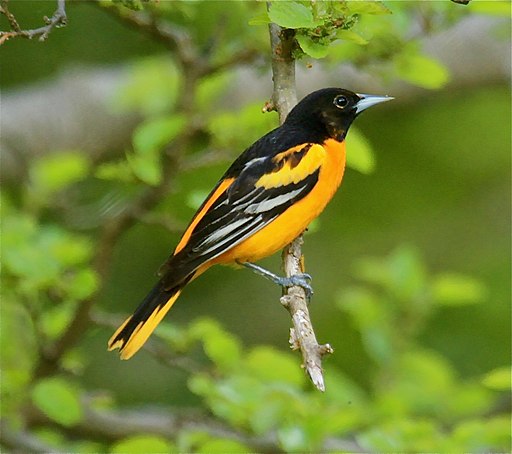Baltimore Oriole
Icterus Galbula
Written by Kathy Richards
HABITAT:
It is found throughout New England though is rare in the winter. In the summer it is found from Alberta west to Newfoundland south to GA and west to LA & TX. The oriole prefers open deciduous forests, shade trees along roadsides, orchards, parks, cemeteries and pastures with tall shade trees. You will not find them in dense forests. In the fall most migrate south to the southern US and Mexico though some will stay in New England.
They have benefited from people moving into breeding ground because forests get thinned and cut.
BEHAVIOR:
The phoebe is one of the first spring migrants to return. It catches its food on the wing and is aided by its sharp pointed bill with bristles at the base of the beak. The phoebe is an extremely agile flyer making quick sharp turns and tumbling while flying. They will also have a couple of perches on low trees or fence lines to catch insects. While perching the phoebe will often wag its tail up and down.
The phoebes call is a monosyllabic 2 note call saying phoe-be with the first syllable accented (unlike the chickadee which is more melodic)
NESTING:
The Baltimore Oriole will mostly nest in tall deciduous trees which are either growing by themselves or in small groups. The female builds her hanging nest on a slender drooping branch high up in the tree. The pouch like hanging nest is woven using plant fibers, milkweed stalks, strips of bark, plant fibers, horsehair, string and/or cloth. A suspension is woven over the branch and the bottom of the nest is rounded and cushioned. 4-6 eggs are laid the end of May to the beginning of July. Eggs hatch in 12-14 days.
FOOD:
Insects, fruit (especially dark fruit like dark mulberries, the reddest cherries and deep purple grapes), nectar and insects (especially caterpillars in the summer)
Can be attracted to feeders with jelly or cut fruit like oranges.
PREDATOR:
Grackles, crows, blue jays, squirrels, house cats, owls, Cooper’s and Sharp-shinned hawks.


